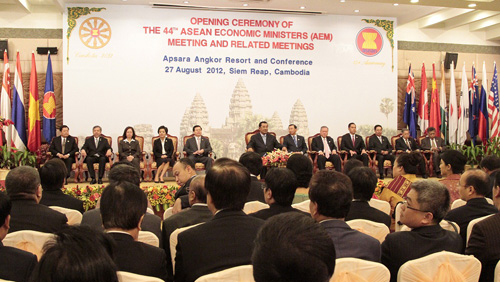Viet Nam ready for the 19th AEM
VGP – Viet Nam is finalizing its preparations for the 19th ASEAN Economic Minister’s Retreat and Related Meetings scheduled from March 6 to 9, 2013 in Ha Noi.
 |
| ASEAN Economic Ministers meets in Phnom Penh, Cambodia, August 2012 |
AEM is an annual event of ASEAN economic cooperation pillar, with the participation of 10 ASEAN Economic Ministers and the ASEAN Secretary General.
According to Deputy Minister of Industry and Trade Nguyen Cam Tu during a press conference on February 27, the ASEAN Economic Minister’s Retreat (AEM) is an important dialogue amongst Ministers with regards to essential initiatives to strengthen economic cooperation in the region and set the directions for economic integration activities in 2013, towards the establishment of the ASEAN Economic Community (AEC) by 2015.
ASEAN integration process is not independent from global economic developments. Therefore, ASEAN, on the one hand, promotes trade, investment and economic linkages between ASEAN and its dialogue partners, and on the other hand, strives to maintain its centrality in the evolving regional structure.
ASEAN is currently engaged in realizing the Free Trade Areas (FTA) with China, the Republic of Korea, Japan, India, Australia and New Zealand.
In 2013, ASEAN and these six FTA partners will commence negotiating on the Regional Comprehensive Economic Partnership (RCEP), planned to be completed by the end of 2015, which aims to strengthen ASEAN’s centrality in the regional integration process and create the ever largest free trade area in the world, with total population of greater than 50% of the world’s population, and an aggregate GDP equaling to nearly 30% of global GDP.
Scheduled within the agenda of the 19th AEMR, the 12th Consultation between ASEAN Economic Ministers and the EU Trade Commissioner will be held on March 9. This will be a chance for ASEAN and the EU to discuss the programs and initiatives aimed to promote economic cooperation, trade and investment relations between the two regions.
Also held on March 9, the 3rd ASEAN-EU Business Summit will be participated by about 600 business leaders from ASEAN countries and the EU. The Summit will provide an opportunity for a higher level dialogue between policymakers and discussions over inter-sectoral issues, experience sharing and networking within the business community, in order to further enhance the potentials of trade and investment between ASEAN and the EU.
Deputy Minister Tu affirmed: “As the Country Coordinator for ASEAN-EU economic cooperation, Viet Nam is making her best efforts to contribute to the economic integration within ASEAN as well as the promotion of ASEAN-EU trade and investment”.
To Viet Nam, ASEAN and the EU are amongst the most important trade and investment partners. The EU is the second largest export market and one of the most important investment sources of Viet Nam.
Meanwhile, ASEAN is currently Viet Nam’s third largest export market and the second largest source of goods. Trade turnover of Viet Nam to ASEAN countries in 2012 reached over US$38 million.
|
ASEAN Economic Community 2015 is regarded as (a) a single market and production base, (b) a highly competitive economic region, (c) a region of equitable economic development, and (d) a region fully integrated into the global economy. To date, ASEAN has completed 74.5% of the measures inscribed in the ASEAN Economic Community Blueprint. The remaining stumbling blocks are present mainly in the areas of trade facilitation, services, investment and transport. In addition to fulfilling these remaining measures, ASEAN also needs to pay attention to the development level differences, seen as gaps between ASEAN Member States. |
By Thuy Linh

